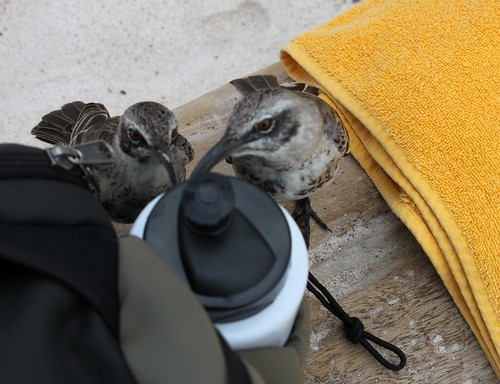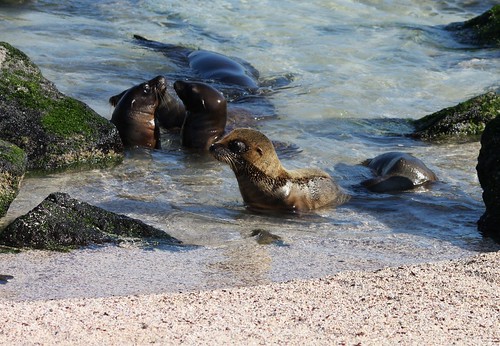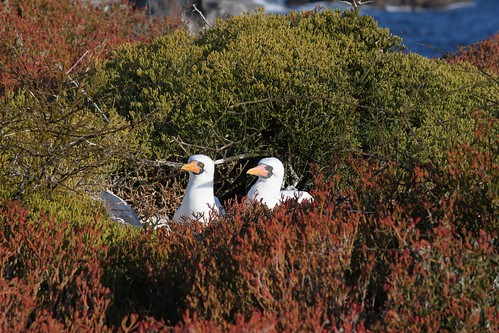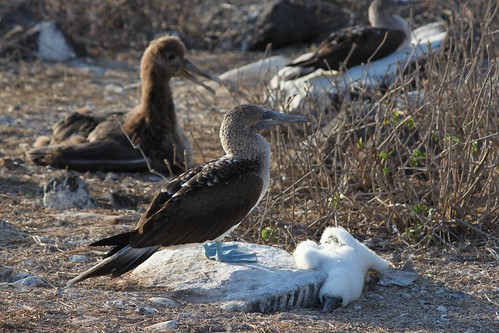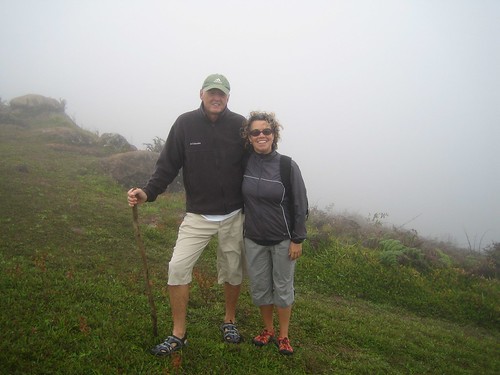On Saturday, November 27 we began our long awaited 4 day cruise to the SE islands which as you know are the oldest islands in the Galapagos as they were formed at the NW hot spot then migrated to the SE. Consequently they are eroded and flatter with more vegetation.
We boarded our yacht Galaxy in Puerto Ayora harbour at noon and relaxed while waiting for the rest of the tour group who were arriving by air from the mainland.
The yacht had capacity for 16 but it turned out our group was only going to be 9. (Yay for last minute booking). Sally and I were accompanied by our friend Richard, a visiting scientist from Australia, and we joined a young couple from Switzerland who were already on board. Arriving by plane were two British couples who completed our group. An excellent mix of people and a first rate crew and guide made for a memorable trip. Everyone got acquainted over our first of several tasty meals together and went to bed knowing that when we woke up the next morning we would be anchored off Isla Floreana.
Breakfast every day was at 7am and in the interest of brevity, let me say that all breakfasts, lunches and dinners were very good. By 8 am, we were onshore at Punta Cormoran where we walked to a nearby brackish inland lagoon frequented by flamingos.
The lagoon was very low but we did see two flamingos at a distance which official photographer Sally captured with her big new telephoto lens.
A short walk in a different direction took us to a brilliant white sandy beach well known as a green sea turtle nesting site. The turtles were cruising just offshore when we visited and come on land at night to lay their eggs. Back at our landing site we went snorkeling and were lucky enough to swim with a turtle.
After lunch on board, the yacht moved along the coast to anchor in Post Office Bay. This is the spot where in 1793 ships bound for the Pacific whaling grounds would leave letters in a barrel to be picked up by homeward-bound ships whose crews would deliver the mail by hand. Following tradition, we left some mail so a few of you may receive a card delivered by a stranger. A walk further inland (which we didn’t do) lie the rusted remains of a failed 1920s Norwegian fishing operation.
At 5pm we set out in the panga (inflatable dinghy) in search of Galapagos penguins. We were in luck and got up close to the little guys as they rested on a lava outcrop. We also saw sea turtles along the way and in a quiet spot, resting white tipped sharks.
After another overnight sail or motor if you will, we arrived at Gardner Bay on Isla Espanola. Our morning beach walk started with the now familiar indifferent gauntlet of lobos marinos. All beaches have lobos, all sizes, all the time but this beach had LOTS!
Here is a video of the beachmaster or alpha male who during the breeding and calving season constantly swims back and forth along his sandy turf, barking, warning and chasing off potential rivals.
Also on Gardner Bay, we observed some peculiar behaviour. As soon as we were on shore, we were mobbed by thirsty Espanola mockingbirds (one of four Galapagos species). These hazel eyed residents are constantly in search of water and know that humans have it. While you are not allowed to water or feed them to avoid interfering with the natural order, they hope someone has a leaky waterbottle.
The marine iguanas on Espanola are a subspecies and are more colourful than those on the other islands. During the breeding season, the males’ red and green colouring is even more pronounced.
After lunch we motored for an hour along Espanola arriving at Punta Suarez where for the first time we had to share an island with a large cruise ship. This stop to visit the waved albatross nesting ground was the main reason we took the cruise, and I felt frustrated about sharing the space. No worries, it all worked out. On shore while getting organized for the birdwalk, we watched a group of sea lions with many young playing in the shallows and newborns that were barely able to nurse. The barking beach boss was never far away.
The walk exceeded expectations. We saw not just one or two albatrosses but a whole field of juveniles, many with partial baby feathers.
This nesting ground was the same one you see in the National Geographic videos, and it was a different feeling to be there with these stately and at the same time goofy looking birds.
In the video below we captured a juvenile prompting its parent for food.
On the ground, albatrosses waddle like big slow ducks but in the air they are masters of grace and power.
While we came to see the albatrosses, other birds nest in this area too. There were boobies everywhere.
Our cruise ended the next morning in Puerto Baquerizo Moreno on Isla San Cristobal, the provincial capital. We visited the interpretation centre which opened in 1998 and does a beautiful job of presenting the human and natural history of the islands with an emphasis on conservation issues. Behind the centre we did a short hike to see the statue of a young Charles Darwin located at the spot where he first set foot in the Galapagos in 1835.
That afternoon we took a taxi to the highlands to visit El Junco, the only year round fresh water lake in the Galapagos. Our hotel owner warned us that given the weather conditions, the lake could be fogged in. She was right. We couldn’t see a thing. We have pictures to prove it. If we get the chance, we’ll return to San Cristobal and try again.
More photos from our trip:
http://www.flickr.com/photos/sataylor/sets/72157625458213919/








